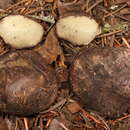ar
الأسماء في صفحات التنقل


Rhizopogon vinicolor ist eine Pilz-Art aus der Familie der Wurzeltrüffelverwandten. Es handelt sich um eine Sammelart für Ektomykorrhizen, die mutualistische Beziehungen mit Douglasien (Pseudotsuga spp.) ausbilden.
Die Fruchtkörper von R. vinicolor werden unterirdisch ausgebildet. Sie haben einen Durchmesser von 10 … 33 Millimetern, sind rundlich oder unregelmäßig geformt und von schmutzig-weißer Farbe; im Verlauf der Reifung werden sie rot. An der Basis sitzen ein paar wenige Rhizomorphe. Das Peridium besteht aus einer einzigen Schicht von Hyphen und wird – an die Oberfläche gebracht – weinrot. Die Gleba ist fest und lederig-gelb gefärbt; sie dunkelt mit zunehmendem Alter. In ihrem Inneren finden sich kleine labyrinthische Hohlräume. Die Trama ist mit Basidiosporen wohlgefüllt. Diese sind elliptisch bis eiförmig und messen 5 … 9 × 3 … 5 μm. Sie haben kein Septum und sind glatt und hyalin. Die „Kordeln“ des Myzels sind nur in geringer Anzahl oder gar nicht vorhanden.[1][2]
Obwohl einige Autoren behaupten, dass R. vinicolor ausschließlich mutualistische Beziehungen zu Douglasien eingehe, sind andere der Meinung, dass die Art auch bei Ponderosa-Kiefern (Pinus ponderosa) und weiteren Kiefern- oder Tannen-Arten Mykorrhizen bildet.[1] Die Bäume ziehen Vorteile aus dem saprophytischen Pilz, welcher die Nährstoffe aus der Laubstreu und verrottendem Holz verfügbar macht, während der Vorteil der Pilze darin besteht, dass die Bäume über Photosynthese Kohlenhydrate für sie verfügbar machen.[3]:275–276
Die Westamerikanische Rötelmaus (Myodes californicus) ist eine von zahlreichen Nagetier-Arten, die die Fruchtkörper fressen. Die Sporen passieren anschließend den Verdauungstrakt der Rötelmaus und werden in ihren ausgedehnten unterirdischen Bauten mit den Kot-Pellets verteilt. Da sie noch lebensfähig sind, werden die Pilze auf diese Art und Weise verbreitet und können mit noch nicht infizierten Bäumen Assoziationen bilden. Es wurde festgestellt, dass bei Kahlschlag und Entfernung allen Totholzes R. vinicolor und andere Mycorrhiza-Pilze die Ausbildung der Fruchtkörper stoppen, die lokale Rötelmaus-Population ausstirbt und die neu gepflanzten Bäume nicht mehr gedeihen.[3]
Die Art wurde von dem US-amerikanischen Mykologen Alexander H. Smith 1966 erstmals beschrieben.[4]:67
Eine Reihe von Rhizopogon-Arten sind sich morphologisch so ähnlich, dass sie als Sammelart R. vinicolor zusammengefasst wurden. Eine phylogenetische Untersuchung von R. vinicolor, R. diabolicus, R. ochraceisporus, R. parvulus und R. versiculosus wurde 2002 publiziert. Die Arten können demnach in zwei getrennte Kladen gruppiert werden, die mit R. vinicolor und R. versiculosus bezeichnet werden.[5]
Rhizopogon vinicolor ist eine Pilz-Art aus der Familie der Wurzeltrüffelverwandten. Es handelt sich um eine Sammelart für Ektomykorrhizen, die mutualistische Beziehungen mit Douglasien (Pseudotsuga spp.) ausbilden.
Rhizopogon vinicolor is a species complex of ectomycorrhizal fungus which forms a mutualistic relationship with the Douglas-fir (Pseudotsuga spp.). The species was first described scientifically by American mycologist Alexander H. Smith in 1966.[1]
A number of species of Rhizopogon are morphologically similar and they are collectively known as the R. vinicolor species complex. A phylogenetic investigation of R. vinicolor, R. diabolicus, R. ochraceisporus, R. parvulus and R. versiculosus was published in 2002. It was determined that they separated into two distinct clades, R. vinicolor and R. versiculosus.[2]
The fruit bodies of R. vinicolor are produced underground. They are 10 to 33 millimetres (0.4 to 1.3 in) in diameter, rounded or irregularly shaped, of a dirty white colour, later red, and with a few rhizomorphs at the base. The peridium is a single layer, becoming wine-red when exposed. The gleba is firm and buff coloured, darkening with age, with small labyrinthine locules. The trama are well-filled with basidiospores. These are elliptical to ovoid, 5–9 × 3–5 μm, do not have a septum and are smooth and hyaline. The mycelial cords are few in number or absent altogether.[3][4]
This species forms a mutualistic relationship with coniferous trees. Although some authorities state that R. vinicolor associates exclusively with the Douglas-fir, others mention it being found in association with the ponderosa pine and other pines and firs.[3] The trees benefit from the saprophytic fungus which makes nutrients available by breakdown of the leaf litter and rotting wood, while the fungus benefits from the trees' photosynthetic mechanisms which produce carbohydrates.[5]
The western red-backed vole is one of a number of rodents that feed on the fruit bodies. The spores then pass through the vole's gut and are deposited in faecal pellets throughout its extensive burrows. The spores are still viable and this enables the fungus to spread and form associations with uninfected trees. It has been found that if a forest is clear cut and all the dead wood removed, R. vinicolor and other mycorrhiza stop fruiting, the vole population dies out and any newly planted trees fail to thrive.[5]
Rhizopogon vinicolor is a species complex of ectomycorrhizal fungus which forms a mutualistic relationship with the Douglas-fir (Pseudotsuga spp.). The species was first described scientifically by American mycologist Alexander H. Smith in 1966.
Rhizopogon vinicolor je grzib[1], co go ôpisoł A.H. Sm. 1966. Rhizopogon vinicolor nŏleży do zorty Rhizopogon i familije Rhizopogonaceae.[2][3] Żŏdne podgatōnki niy sōm wymianowane we Catalogue of Life.[2]
Rhizopogon vinicolor je grzib, co go ôpisoł A.H. Sm. 1966. Rhizopogon vinicolor nŏleży do zorty Rhizopogon i familije Rhizopogonaceae. Żŏdne podgatōnki niy sōm wymianowane we Catalogue of Life.